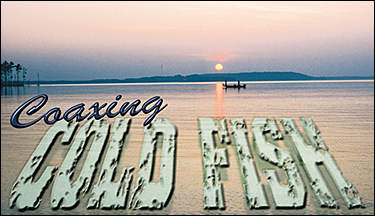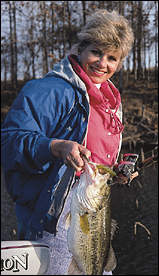
Sometimes you need a lot of finesse.
By Paul A. Cañada
I will never forget the day I met Skinny. I was shopping for Kalin western-style worms at the Bass House's now defunct Fort Worth store. Having selected a number of bags of the popular finesse worms, I made my way up to the store's only cash register.
I placed the worms up on the counter and reached for my wallet, when an authoritative voice noted matter-of-factly, "You'll catch some good fish with those."
I looked up at the cashier but his blank stare confirmed he wasn't the source of encouragement. "Over here," a voice beckoned. "Where are you going?"
Looking over the cashier's shoulder, I spied a character precariously balanced on a tall stool. His crossed arms led me to believe he had nothing better to do than spend hours harassing the shop owner and giving helpful advice.

Texas Pro Kathy Magers holds up a nice cold-weather bass. Finesse versions of plastics fished vertically over fish are excellent cold-water choices.
|
Little did I know that my read would prove correct.
That bar-fly, worm bar-fly that is, was Fort Worth's own Skinny Harris-a retired General Dynamics supervisor. Since that chance meeting 4 years ago, I have come to know this North Texas' bassin' icon fairly well.
Shucks, the opinionated Harris has even been known to hang with Wortham's gang at Doreen's 24 HR Eat Gas Now Café.
Although most Texas anglers aren't familiar with Fort Worth's Harris, the sometime tackle rep is known nationally as the southern angler with Yankee ways. Many believe Skinny to be the slightly better-looking clone of California's Don Lovino-the sultan of doodlin'.
Texas' own version of the famous finesse guru has been featured in many national publications, preaching the gospel of subtleties.
According to Harris, the cold-water period of winter is one of the better times to use Yankee finesse tricks. He argues that bass are typically conserving as much metabolic energy as possible during colder months. As he sees it, the bass aren't going to move a great distance to chase down prey-or, an angler's lure.
"I reason," he explains, "if downsizing baits and slowing down presentations work out west and up north, then why shouldn't they work here in Texas? We face the same issues here; heavy angling pressure, adverse weather conditions and instability in our water conditions. That's why I started using finesse techniques, and based on my results they work."
The North Texas guru practices three important finesse principles when bass are inactive and tough to catch. First, Harris believes, it's important to downsize when necessary. Secondly, he finds it's important to slow down his presentation-matching it to the activity level of the bass. Finally, Harris says he believes it's important to add a triggering agent, boldly predicting, "Practice those three principles and you can't go wrong."
Principle One: Downsize when necessary
When the bass bite gets real tough, the chances are good that Harris will be doodlin' or draggin' a small bait. Whether trying to imitate a struggling threadfin shad falling through the water column or a sluggish crayfish crawling along the bottom, the Texan prefers smaller baits, 3 to 4 inches long. Referring back to his own experiences, Harris says "Back in the old days, when we used to clean and keep bass, we rarely found anything bigger than 3 inches in their stomachs."
The 4-inch hand-poured worm and the 2-inch hair jig are two of his favorite cold-water baits. The hair jig, a bait normally associated with northern smallmouth anglers, can be fished with or without a trailer. Paired with a small pork or plastic trailer, the jig accurately imitates a small crayfish. Fished without a trailer, the hair jig resembles a small baitfish moving through the water.
Harris believes that the hand-poured versions of plastic finesse baits are critical to drawing the toughest cold-water bite. According to the former tournament angler, the real secret to hand-poured plastics is the bait's flat bottom. Skinny lectures, "If we learned anything from the
aircraft industry it's that a flat bottom or underside gives the object-whether that be an aircraft wing or a worm-some lift. That lift causes the worm to wander as it falls through the water column. A hand-poured worm doesn't fall straight down through the water column like a round worm does; it slides or glides as it falls."
Because cold-water bass tend to hold in tight schools and in relatively deep water, these two baits are generally more effective when fished vertically over fish. Harris will often fish hand-poured plastics on a "suspend-doodle" rig. This rig allows the finesse angler to place and keep the presentation in the bass' relatively small strike zone while maintaining direct contact with the smaller bait.
The suspend-doodle rig consists of a 3- to 6-inch hand-poured soft-plastic bait, fished precisely above a brass weight and glass bead. Harris leaves a 2- to 4-foot tag of monofilament line when tying on his hook. A 5/32- or 3/16-ounce brass weight is slid up the tag end, followed by an 8MM glass bead. The glass bead is then pegged in place with Top Brass' Peg-It.
continued
page 1 / page 2
| 




